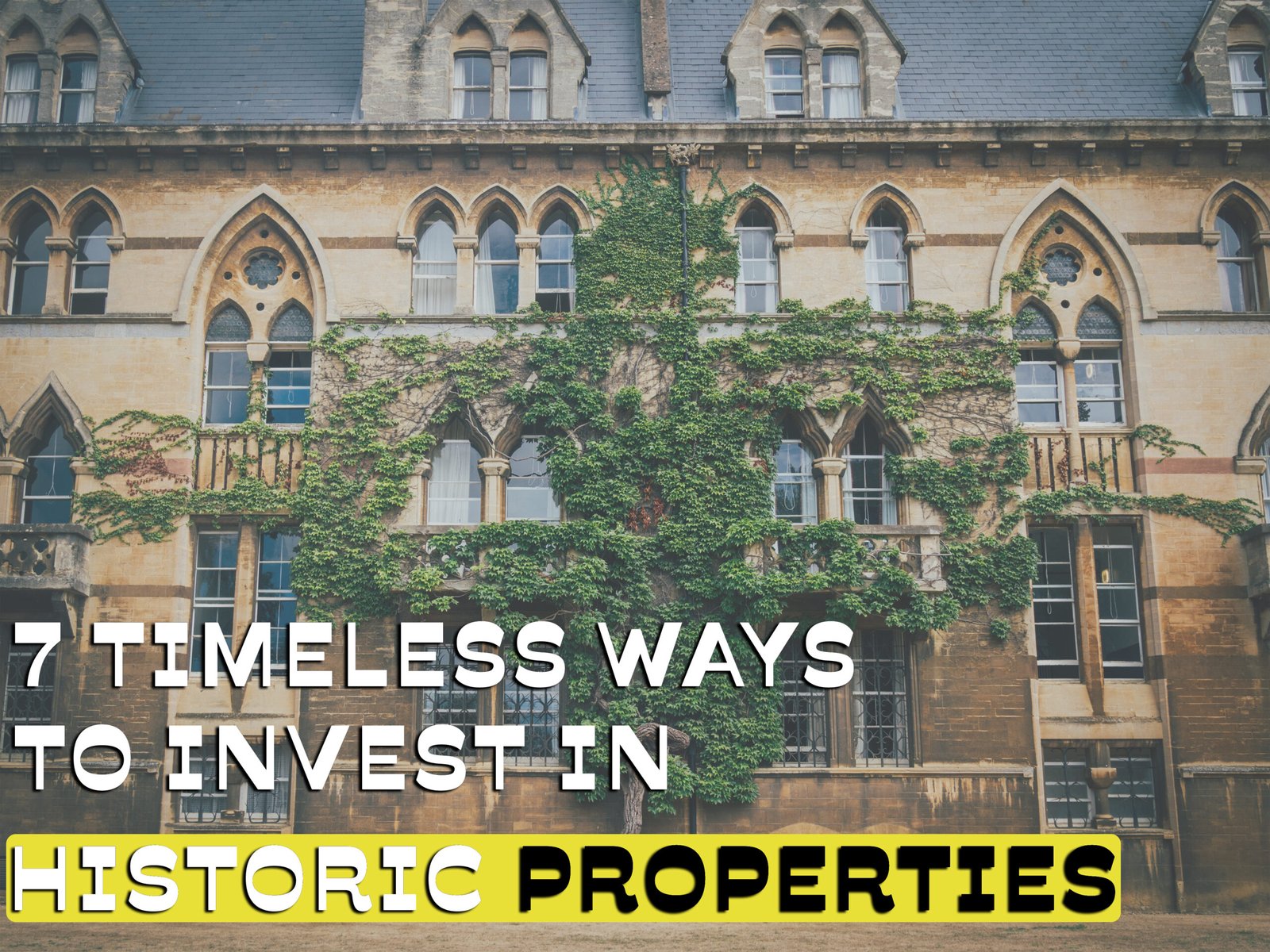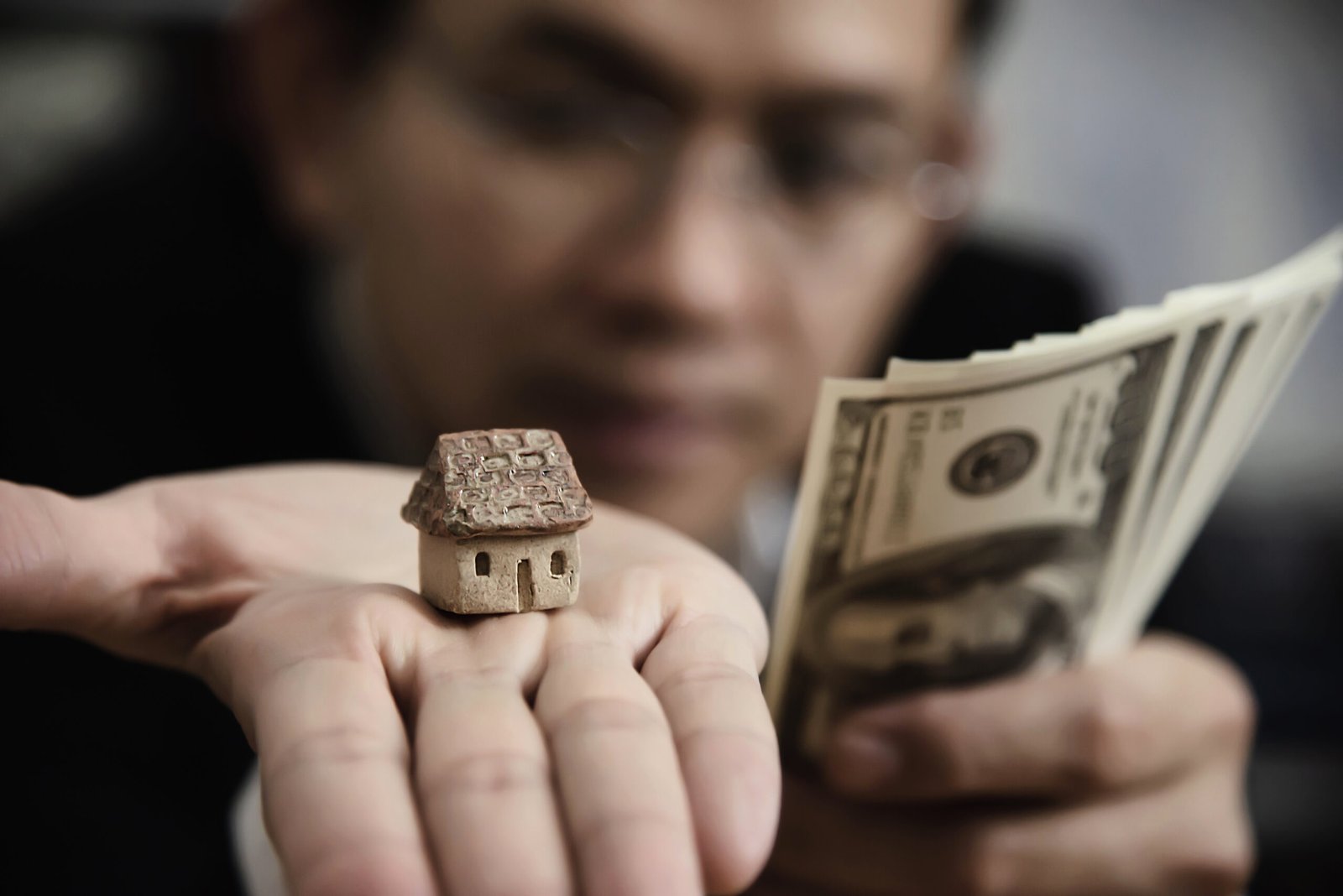Discover 7 Timeless Ways to Invest in Historic Properties. Preserve heritage, build long-term wealth, and unlock rare real estate opportunities with ease.
Introduction of Invest in Historic Properties
To a building, there is something historical. The stained glass windows, the grand ironwork, the groaning staircases—each of them has a story to tell. In a world racing headlong into the modern and the modular, heritage and historical buildings are the new trends. These buildings provide investors with something more than cold money; they provide a cultural as well as an emotional one. Its growing popularity is fueled by people wanting to be unique and original, to be, to travel, or to own a friend.
Purchasing an older building is keeping up with the past and profiting from it if one can handle it. They tend to be in the center of old towns, on quaint main streets, or within historic preservation areas—most of the best tourist and commercial sites. But they also include additional headaches, from stringent codes for rehabilitation to high-cost insurance premiums.
This is a strategic and tactical review of why historic real estate is an incredible investment tool for your portfolio. We’ll discuss the benefits, money risks, restoration expectations, and how to search for a heritage home that will help you achieve your long-term objectives. If you restore a Victorian home, own a boutique hotel, or just live in a storytelling home, you should be in the know.
Expect a step-by-step perspective on how to evaluate, finance, and legally prepare for such an investment. We’ll also cover how to assess a property’s historical value, tap into available grants, and turn a character-filled asset into a smart financial move. While passion plays a role, this guide ensures your decisions are rooted in a financial sense and planning, not just nostalgia.
If you desire a residence that is not another generic cookie-cutter condo and not another generic new development, then this book is meant to guide you through the complex but rewarding world of historic property.
What Are Heritage or Historic Properties?
Heritage or historic structures are structures preserved because they are of historical, cultural, or architectural significance. The terminology may be geographically diverse—”historic” in the US is more common than “heritage” there, but “heritage” is utilized in Europe and Commonwealth countries—but both refer to structures that are part of a culture’s heritage.
These kinds of listings are usually taken up by preservation societies, heritage societies, or government ministries. The property can be listed according to its architecture, its historicity from being linked to a particular event or person in history, or just for being typical of a particular period in time. These ministries would normally publish lists of listed properties and stipulate the policy for their conservation.
They might be colonial mansions, Victorian houses, Art Deco office buildings, lighthouses, mills, or even old post offices or railway stations. They might be for living, business, or civic purposes, but the only thing they have in common is that they are controlled or managed so that their heritage significance is not lost.
When these qualities are identified, they fall under rules that limit certain upgrades or mandate certain products and techniques. While controls may be limiting, they also save value and prevent your investment from unwanted neighborhood growth.
The most advantageous of these categories is the second, i.e., new fixtures may be installed or walls knocked down in a heritage building without approval. If you’re buying a building on the basis that it can be done, you may have costly delays or penalties. Nevertheless, the character, uniqueness, and old-fashioned looks of heritage buildings can easily more than compensate for such restrictions if done sensibly.
Why Invest in Historic Properties
The popularity of character homes has become extremely high over recent years. Buyers and renters alike are desperate in growing numbers for houses and offices that have about them an aura of distinctiveness, and older houses and business buildings well outmatch newer ones in this regard. Their architectural ornament—those curving entranceways, period moldings, stained glass—irreplaceable in toto, never mind at affordable cost, in new buildings.
The largest economic advantage is that they’re scarce. About newly built structures that can be built in infinitely variable ways, there’s only so much bulk of heritage buildings. That scarcity is precisely why it drives such high demand, especially when redeveloping neighborhoods. For those who’d like to recycle properties such as these into bed & breakfasts, restaurants, galleries, or co-working offices, value isn’t necessarily in square footage, but in the story.
The other significant benefit is the tourism prospect. Heritage quarters of cities like Charleston, Edinburgh, and Lisbon have witnessed the highest demand for short leases in their heritage buildings. They can all be run smoothly as boutique hotels or short-let buildings on Airbnb. Placing them in cultural pockets guarantees high footfall and exposure.
The investment financial return, naturally, is that in certain instances, there are governments that provide tax credits, low-interest loans, or grants to maintain older buildings. Those can simply help decrease your cost of maintenance and ownership.
For instance, for instance, the United States provides up to 20% tax credit for qualified rehabilitation on income-producing historic properties.
Also, long-term growth is consistent. Contrary to hip new houses that become obsolete, aged structures get smart. In the case of proper maintenance, they grow beyond the rate of the market, particularly in town or heritage corridors.
Key Challenges and Risks Of Investing in Historic Properties
Although the promise and potential are enticing, old-fashioned property investment is hardly hiccup-free. Its biggest one is that it is very strict about renovation codes. Whatever structural rehab you do, it is going to have to pass through conservation agencies. You can be barred from installing aluminum frames to wood windows, for example, or restoring a facade with old materials.
Maintenance costs are sometimes higher because of the specialized craftsmanship requirements. Contractors who understand vintage woodwork or stone masonry offer premium services. And if you’re working with older infrastructure, they provide outdated wiring or plumbing that can surface, which is not long-term and liable.
The second threat is a delay in permits. Small enhancements have even design requirements or city planning commission hearings that stretch out schedules significantly. Such delays might influence rental returns or delay a commercial roll-out.
There is also less liquidity to be concerned about. An old house in a very popular location will sell quickly, but a less well-known property will take longer to sell because it attracts a niche population of buyers. Your exit strategy for investment must be part of your investment plan.
Lastly, it is very costly to insure. The policy might have lesser coverage or payment of massive premiums due to expected risk and rebuild costs. You might be obligated to buy specialty historic property coverage with its special conditions and requirements.
Financial Planning for Historic Property Investments
Before purchasing, there needs to be a clear financial plan. Begin with estimates of restoration and compliance costs. Get realistic estimates—not merely materials, but time investing in dealing with the permitting process—from architects or contractors who work on historic restorations.
Lastly, determine your ROI. Do you sell it, rent it, or do you keep it? Short-term rentals will be paid sooner but incur maintenance fees. Event venues or leasing it long term will take a while to break even but offer you steady cash flow.
Look for grants or sources of funds. There are a number of local authorities and non-profit organizations that provide funds to save listed buildings. They can repay you some of your restoration costs or reduce your tax designation.
It is also important to build a team. Employ experts like historic appraisers, structural engineers, and preservation architects. Not only will they make your project compliant with the law, but they will make the investment financially and structurally sound too.
Lastly, research specialty finance. Some lenders offer loans to old buildings exclusively, like rehab funds or special preservation rates for projects. Your standard mortgage will not be flexible enough to work for you.
Best Ways to Invest In Historic Properties
Buying a heritage or old building exposes one to a broad brush of unconventional and occasionally lucrative uses that a new building would not have. The buildings are blessed with pre-existing character and cultural depth that can turn ordinary business investments into experiences. From boutique hotels to specialized stores, the possibilities are as diverse as they are extremely innovative and bricked, restrained only by zoning and the state of the building.
Whether you’re seeking long-term passive income or want to build a lifestyle business rooted in storytelling and ambiance, understanding how to leverage a historic space as a good investment for your generation. These Restrictions are especially appealing in tourism-driven towns or revitalized urban districts where the demand for authenticity is high.
The following are 10 of the most effective and rewarding ways to make your wealth in a heritage property.
1. Boutique Hotel or Bed & Breakfast
Most in demand is to purchase an old house or building and turn it into a boutique hotel complex. The rich architectural details, antique charm, and heritage, by definition, appeal to the sightseeing tourist who wants something beyond the ordinary hotel experience.
Operating a B&B may be very profitable, especially in tourist towns or cities where they have nowhere to sleep. The fact that it’s old is a better appeal than new hotels, which will be cookie-cutter. Restoration is governed by preservation regulations, but your restored original charm of the interior may be your selling feature.
It also allows you to live on the property (if you prefer), maintaining low costs. Just forecast hospitality licensing, safety codes, and upkeep, all of which will be accounted for, but it will be beneficial in the long run.
2. Event Venue (Weddings, Art Shows, Conferences)
The old construction sare the perfect venue for functions if it possesses glamour, elegance, and cozy rooms. They possess magnificent ceilings, old ballrooms, and open courtyards, which more often than not render them perfect for weddings, corporate retreats, or ethnic celebrations.
There is more demand for event spaces in which something extraordinary could be had. Instead of leasing mundane halls, couples and companies would want rooms that have some history behind them. This will enable your niche product to make the distinctive selling point of your building, Boutique hotels so you can charge premium prices.
Of course, the inclusion of local hosting event regulations, fire codes, and access standards will have to be included in your design and budget for renovations. But there, it can yield high returns during spurt times for peak seasons.
3. Specialty Café or Themed Restaurant
The majority of the historic constructions are situated along main streets or central business districts, which are perfect locations for restaurants and cafes. A warm tea room within a Victorian parlor or a cozy eatery within an old colonial house can turn a meal overnight.
The ambiance that comes with the old buildings attracts clients even before they have a glimpse of the menu. With innovative branding and slight interior modification (and thereby heritage items are not tampered with), your aura is infused with the essence of the place as food.
Food service permits are a hassle to get, and the kitchens might have to be redone. But business-wise, these enterprises are humming with local businesses and tourist businesses.
4. Antique or Vintage Retail Space
A vintage building is the most suitable space for antique, craft, or vintage items retail. The vintage ambiance makes the customer feel at ease and remain for longer, and heightens the number of sales.
Specialty theme shops—record stores, bookstores, or craft shops—can thrive in historic districts, especially in shopping-convenient, small historic tourist or small city districts. The atmosphere of the old wood cornices, creaking floors, and ornamented cornices becomes the setting as well as the merchandise presentation.
These firms and low overhead and local integration also go together just as well. If your building is in a walkable neighborhood with high traffic, it can be a great spot for an environmentally friendly local business.
5. Art Gallery or Creative Studio
To artists, owning one of these older structures could be more than a business opportunity—it’s the key to sharing art, teaching classes, or creating cultural productions. The peace and beauty that the majority of these older structures simply seem to crave are artistic endeavors.
Historic buildings, historic churches, or warehouses may be repurposed as cooperative studios or galleries. Artists appreciate the history of the building, and people will be more inclined towards exhibitions in such experiential spaces.
You might even be eligible for grants from the city’s public or cultural funds to subsidize the cost of it. The local good of having local art is a dividend and value added to the investment.
6. Professional Offices or Consulting Spaces
Designing firms, law firms, architecture firms, and wellness consultants usually prefer to have unique office space that is different in character. To have office space for lease in a restored old building might appeal to one who wishes to be different from the corporate herd.
Heritage space tenants value the character, privacy, and uniqueness of heritage spaces. You can lease out separate rooms for office purposes or even completely furnish them for co-working without compromising the character of the building.
Tax breaks or subsidies for mixed-use commercial zoning for specific groups are available, especially for services that will benefit community development.
7. Educational Center or Heritage Museum
An educational function of an old building—e.g., a cultural facility, history museum, or language school—is a beautiful union of purpose and building. The visitors and students learn more easily in an atmosphere that is fluent with history.
These functions can generate university alignments, city commission participation, or non-profit sponsorship. Planned well, you may have solid funding, volunteer hours, and civic traffic.
Notice that these uses need not necessarily be profitable but may be sustainable in the long term with additional tax benefits, particularly to a registered school of learning or charity.
Legal Concerns Before You Purchase
Purchasing an older building assumes a bundle of legal concerns. Restoration and rehabilitation frequently need to be compliant with heritage conservation acts. This can limit the extent to alter the frontage, join on, or even change doors and windows.
Also, the use of the property might be restricted by zoning laws. A retired housing residence can’t be converted into a commercial center unless a zoning variance is obtained. Always make sure to inquire about this with lawyers or municipal officials.
Check if the property is on a local or national preservation board list, since that will decide what type of changes can be done. Other properties with historic treaties or heritage preservation fix the construction forever and affect resale or remodeling.
Disregarding these policies can result in high fines, legal action, or revocation of permits, so take the initiative to read up ahead of time initial to signing the sales agreement.

How to Choose the Perfect Historic Property
Next, consider where it is situated. City houses are more suited to rent or utilize as tourism houses, while country houses may be perfect for private getaways or parties.
Second, think about the state of the building. Some buildings would need a full restoration, some cosmetic repairs only. A structurally unsound building will spend your money very fast.
Consider your usage. Commercial, private residence, or mix? It will depend on what level of renovation needs to be performed and what regulation governs.
Always conduct market research. See whether tourists visit the area, what the local rents are, and whether other comparable heritage buildings are profitably utilized.
Lastly, have a proper inspection—structural, legal, and architectural—done before buying. These will reveal the problems behind the beauty.

Is This Investment Right for You?
It’s not a playing-it-by-ear thing. It’s one of the balanced acts of head and heart. For the history enthusiast and architecture aficionado, and for the person who can endure red tape and costly maintenance, it might be worth it in terms of money and feelings.
Heritage houses will attract those who would like to leave something behind to inherit and maximize their uniqueness. If you are determined, diligent, and keep the long-term perspective in mind, this niche home is profitable and fulfilling.
But for those who like low-maintenance speed-flip transactions, this path might be too much trouble. Work through the possibility with as much detail as you would any investment—numbers, condition, and market demand, not just curb appeal.
Advantages and Disadvantages of Historic Property Investment
Historic home investment gives an emotional, cultural, and financial reward, but risk. Preservation or passive investing-based, you should understand the pros and cons prior to delving into this niche market.
✅ Advantages
- Historic Appeal Increases Market Demand
The construction has distinctive architecture, ornamentation, and interesting history, all of which contribute to enhancing its attraction to customers, tenants, and visitors seeking trustworthiness.
- Government Tax Credits and Incentives
Governments provide owner-occupants a variety of permits, credits, and low-interest loans to manage restoration work on heritage constructions.
- Tourism and Possible Community Use
Tourist town heritage buildings are an attraction in themselves—ideal for B&Bs, cafes, or museums, attracting foot traffic and dollars.
- Long-term Asset Growth
Increasingly less ordinary restored heritage buildings, their long-term worth appreciates, especially in high-demand heritage precincts.
- Civic Pride and Legacy Influence
Having history within reach does give a sense of mission, community service, and respect for the community—something not every investment offers.
❌ Disadvantages
- Strict Rules and Regulations for Preservation
Color schemes, restoration, signage, and even interior transformation may need to be approved or meet standards characteristic of the past.
- Exorbitant Restoration and Maintenance Costs
Specialized services and materials are sometimes required to preserve older buildings in structural integrity and architectural attractiveness, with costs expended initially and later.
- Limited Buyer or Tenant Market
Not every customer or leaseholder wants to reside in a heritage home due to maintenance concerns, lack of modern conveniences, or stylistic limitations.
- Insurance Problems
The cost of insuring historic buildings can be far higher due to their age, exposure to the elements, and susceptibility to replacement.
- Unpredictable Approval Timelines
Permits and zoning approvals can take months, placing business plans or restoration timetables well in the rearview mirror.
FAQs: Invest in Historic Properties
Do more mature buildings enjoy depreciation faster than regular homes?
Yes, especially in expanding cities or resort communities, as they are less replicable and more unique.
Can I retrofit the interior of an older building?
Usually, yes, though with permission for building modifications or historic preservation.
Are there tax advantages to a historic property?
There are tax credits or restoration grants in most places, especially for income-generating use.
How long does it take to renovate a heritage home?
It depends. The repair will be done in months in a straightforward way; a full renovation job will take more than one year due to bureaucratic lag.
Conclusion:
Investing in historic or heritage property can be such a richly rewarding endeavor—financially, emotionally, and socially. It is not brick and mortar; it’s a bundle of character, history, and culture that, with proper care, can be rewarded in abundance.
Overall, heritage property is not for the weak at heart. It takes passion tempered with pragmatism. One should expect to haggle over technicalities of the law, expensive deliberation, and time-distant timelines. But to dreamers, to long-sufferers, to heirs-aware, the return can be immense—everything from success in commerce to dividends to society.
Prior to diving in, research: study the state of the property, local demand for property, sources of capital, and final goals. Bring in preservation architects, attorneys, and tax consultants familiar with heritage investing. Historic property investing can be a solid profit and inheritance to keep when executed and in place.
References:
- National Park Service – Historic Preservation Tax Incentives
- The National Trust for Historic Preservation
- Investopedia – What Are Historic Preservation Easements?
- Heritage Canada Foundation – Funding and Grants
- U.S. Department of Housing and Urban Development – Community Development Block Grants
- Real Estate Journal – Investing in Historic Homes: Pros and Cons













